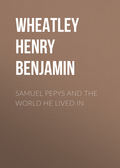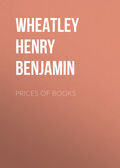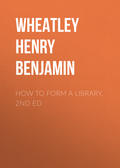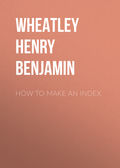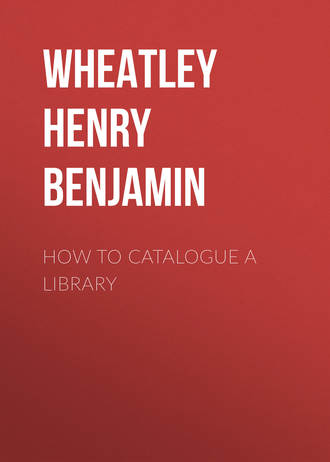
Wheatley Henry Benjamin
How to Catalogue a Library
CHAPTER II.
THE BATTLE OF THE RULES
To Sir Anthony Panizzi we owe rules for the making of catalogues: perhaps it would be more proper to say the codification of rules, for sound rules must have been in the mind of the compilers of good catalogues before his time. When one person makes a catalogue, he usually acts upon principles which are known to himself, although he may not have committed them to writing. When several assistants are employed to make a catalogue, it is positively necessary that the compiler in chief, who will be responsible for the whole work, should give directions to his assistants, so that they may all work on the same plan.
The famous code of ninety-one rules which was given to the world in 1841 (Catalogue of Printed Books in the British Museum, vol. i., Letter A) had for its foundation a small number of rules originally devised by Mr. Baber11 (the predecessor of Mr. Panizzi as Keeper of the Printed Books).
Mr. Panizzi was appointed Assistant Librarian in the British Museum in April 1831, and in 1837 he succeeded Mr. Baber as Keeper. As a new general catalogue was now required, a committee was formed to frame rules for its compilation. This committee consisted of Panizzi, Thomas Watts, J. Winter Jones, Edward Edwards, and John H. Parry (afterwards Serjeant Parry). The plan adopted was for each of these gentlemen separately to prepare rules for the purpose, according to his own views. These were afterwards discussed collectively, and when any difference arose, it was settled by vote. When these rules were complete, they were presented to the trustees by Panizzi on March 18th, 1839, with the following memorandum:—
"Mr. Panizzi has the honour to lay before the trustees the rules, which, under all circumstances, he proposes as advisable to be followed in the compilation of the Alphabetical Catalogue, accompanied by a number of illustrations. Although he is well aware that such rules must necessarily be affected by the haste with which they have been compiled, he ventures to hope they will be sufficiently intelligible to the trustees, and enable them, even in their present imperfect state, to judge of the principles that Mr. Panizzi should wish to see observed. He is fully aware that many cases may arise unprovided for, and that some of these rules and principles may be liable to objections, which may not perhaps appear in other plans, seemingly preferable; but he trusts that what seems objectionable may, on mature reflection, be found in fact less so. He cannot, at present, do more than entreat the trustees to take into their patient and minute consideration every single part, as well as the whole of the plan proposed, and then decide as they may think fit, bearing in mind that, although these rules may, if strictly followed, occasionally lead to what may appear absurd, the same objection, to a perhaps greater extent, may be urged against any other plan, and far greater evils result from a deviation from a principle than from its inflexible application."
The rules were sanctioned by the trustees July 13th, 1839, and printed in 1841. In the note prefixed to the volume of the catalogue then printed Panizzi wrote:—
"The application of the rules was left by the trustees to the discretion of the editor, subject to the condition that a catalogue of the printed books in the library up to the close of the year 1838 be completed within the year 1844."
Panizzi very properly disapproved of the publication piecemeal of the catalogue before it was completed, and eventually he obtained his own way, with the result that the printing was discontinued, and a manuscript catalogue was gradually built up. In the note just referred to he proceeds:—
"With a view to the fulfilment of this undertaking, it was deemed indispensable that a catalogue should be put to press as soon as any portion of the manuscript could be prepared; consequently the early volumes must present omissions and inaccuracies, which it is hoped will diminish in number as the work proceeds."
According to Mr. Fagan (Life of Sir A. Panizzi, vol. i., p. 259), the wasteful publication of the volume containing letter A was due to a blunder in the secretary's department. Apparently the order of the trustees was to have the catalogue ready for the press by December 1844, instead of which it was intimated to Panizzi that the catalogue was to be printed by that time.
Both Panizzi12 and Parry13 pointed out in their evidence before the Commission (1848-49) how wasteful a process it was to catalogue the library by letters instead of cataloguing every book on a shelf at one time. There cannot be two opinions among experienced bibliographers of the absurdity of making a catalogue in such a piecemeal manner, and yet this is a plan of proceeding which the inexperienced in cataloguing are frequently found to recommend. Mr. Parry said: "Not only the printing of letter A first do I look upon to be an entire waste, both of time and money—a waste just as much as if the time were thrown away, and just as if the money had been actually thrown away—but the plan of taking those titles from this large body of titles and sending for the books is a serious waste of time.... In my opinion, volume A, the volume that is now printed, must be cancelled, if ever the whole catalogue is printed. The reason of that would be, that an immense mass of titles, in the further cataloguing of the succeeding portions of the alphabet, would arise to be catalogued under the letter A, which nobody would have anticipated until the whole library was catalogued." The Commission coincided with Mr. Panizzi's view, and incorporated their opinion on this point in the report. The consequence was that Panizzi was allowed to proceed on his own plan, with the result that, in the first place, a large number of volumes of manuscript titles supplementary to the old general catalogue were produced, and subsequently an entirely new catalogue, superseding the old one.
The history of the catalogues of the British Museum Library is a curious and interesting one. A catalogue prepared by Dr. Maty, the Rev. S. Harper, and the Rev. S. Ayscough was published in 1787 (2 vols., folio). This was soon superseded; and in 1806 Sir Henry Ellis and the Rev. H. H. Baber (then Keeper and Assistant Keeper respectively of the Printed Books), carrying out the instructions of the trustees, commenced the compilation of a new catalogue, which was published in 1813-19 (7 vols. in 8 parts, 8vo). Ellis was answerable for the letters A to F, with P, Q, and R; and Baber for the remainder of the alphabet.
Now that we have an excellent catalogue of the library, which we owe to the exertions of Panizzi, we are too apt to forget the services of Ellis and Baber as compilers of the very valuable old catalogue. Panizzi took delight in finding faults in this catalogue, and one of the blunders which he pointed out was the entry of a French translation of one of Jeremy Bentham's works, in which the author's name, having been translated in the title-page of the book into French, was transferred in the same form—"Bentham (Jéréme)"—into the catalogue.14 Doubtless there are many bibliographical mistakes; but it is an excellent practical catalogue, and does the greatest credit to the compilers. Even now, although the print is almost lost in the mass of manuscript, and the volumes are nearly worn out, the copy in the Reading Room may still be used with advantage when a book cannot be found in the more elaborate new catalogue.
In 1847 the Royal Commission, already alluded to, was appointed to inquire into the constitution and government of the British Museum, and the report of the Commission, with minutes of evidence, was published in 1850. This report appeared in a large folio volume of eight hundred and twenty-three pages, which is still full of interest from a bibliographical point of view.
The Commissioners considered arrangements connected with the management which have since been changed, and therefore are of little interest now; but the evidence chiefly related to the new rules for the catalogue, and resolved itself into an arraignment of Mr. Panizzi's plans, with Panizzi's reply to the arraignment at the end of the evidence. The report shows how unsatisfactory were the relations between the officers of departments, and how strong was the antagonism to Panizzi's rules and arrangements among literary men.
Many authors whom one would have expected to know something of the art of cataloguing showed the most amazing ignorance, and a love for careless work that makes us extremely glad that their cause was defeated. Some witnesses exhibited a dislike to the rules merely because they were rules. Mr. J. G. Cochrane, then Librarian of the London Library, in answer to the question, "Have you read the ninety-one rules?" said, "I read some of them, and it appeared to me that they were more calculated to perplex and to mystify than to answer any useful purpose;" and again, when asked, "Do you object to rules in any compilation of catalogues?" he said, "Yes, very much" (p. 460). Further on in his evidence he said, "I think that in bibliography, as well as in geography, it is always advisable to keep as much to uniformity of system as possible" (p. 464). But he did not make it clear how uniformity was to be obtained without rules.
The greatest grievance which "readers" seem to have had is one which we can scarcely realize at the present day. Mr. Panizzi ruled that whoever wanted a book should look it out in the catalogue, and copy the title on a slip with the press-mark before he could receive it. Mr. Carlyle refused to look out in the catalogue for a pamphlet which he knew to be in a particular collection. His account of the matter is as follows:—
"I had occasion at one time to consult a good many of the pamphlets respecting the Civil War period of the history of England. I supposed those pamphlets to be standing in their own room, on shelves contiguous to each other. I marked on the paper, 'King's Pamphlets,' such and such a number, giving a description undeniably pointing to the volume; and the servant to whom I gave this paper at first said that he could not serve me with the volume, and that I must find it out in the catalogue and state the press-mark, and all the other formalities. Being a little provoked with that state of things, I declared that I would not seek for the book in that form; that I could get no good out of these Pamphlets, on such terms; that I must give them up rather, and go my ways, and try to make the grievance known in some proper quarter" (p. 280).
Dr. J. E. Gray expressed the opinion that the feeling against this rule respecting the press-mark was very general (p. 491). It is necessary to bear in mind that "the old system was, that you merely wrote the title of the book you wanted without the necessity of looking for it in the catalogue. If you wanted a particular edition of it, then you looked in the catalogue for the particular title or date, and the book was brought to you if it could be found" (7684, p. 491).
Although many of the witnesses showed a lamentable ignorance of the principles of sound bibliography, others proved themselves quite capable of setting right the ignorant.
The Right Hon. J. W. Croker, when asked, "Are you of opinion that the labour and difficulties in the management and cataloguing of a library increase merely in the same proportion with its extent?" made this very true observation, "I think the difficulties would increase, I may say geometrically rather than arithmetically" (8734, p. 570).
Mr. John Bruce considered it a fault in the new catalogue that the titles were too full (pp. 417-18); but Prof. A. De Morgan pointed out very clearly the many dangers of short titles (p. 427). Mr. Croker strongly advocated the use of long titles. He said: "There will of course be a few remarkable instances of great prolixity of title-page, which really are worth preserving as curiosities, if for nothing else. But generally speaking there is nothing that is quite safe and satisfactory to a person who goes to look for a book, but a full title; I will add, a most important consideration in a library like this, which people come to consult; it has happened to me twice, I think, within the last ten days to find it unnecessary to send for a book that I intended to apply for, by finding an ample title-page, which showed me that I should not find there what I wanted" (8709, p. 567).
Dr. Gray in his pamphlet (Letter to the Earl of Ellesmere, 1849) makes this extraordinary statement: "The works with authors' names, or with false names, should be arranged alphabetically, according to the names of the authors, taking care that the names used should be those that are on the title-pages; and, if an author have changed his or her name, that the work published under the different names should be in different places in the alphabet" (p. 5).
Mr. Parry gave much sensible evidence, and this point was submitted to him. The question of the chairman (Earl of Ellesmere) was, "Have you heard it proposed that each book should be catalogued under the form of name appearing on the title, without any regard to uniformity, and without regard to the different forms of name adopted by an author, or arising from the different languages in which works by the same author may be printed?" Mr. Parry's answer was as follows: "I have never heard that suggested, except by Mr. Gray. I have read it in Mr. Gray's pamphlet; and I have heard it from Mr. Gray when he was an assistant.... I certainly do not wish to be offensive to Mr. Gray, for I have the pleasure of his acquaintance, but I think the thing perfectly absurd. I might be permitted to say, that the noble lord in the chair has published under two or three names; and that I should prefer to see all his lordship's works under one heading, and not scattered in three different places in the Catalogue under the name of Gower, of Egerton, and of Ellesmere.... I remember Mr. Gray used occasionally to come and talk about the Catalogue, but it always seemed to me that he had never given any consideration to the subject. It is by no means an easy thing to make a catalogue; a person to make it, must have a very large and special knowledge of books and of languages" (7338, p. 470).
The witness whose evidence was the most unfortunate for himself was Mr. Payne Collier. He committed himself by submitting some titles which he had made in illustration of his views. There were twenty-five titles, which had been made in the course of an hour. These were handed to Mr. Winter Jones, who reported upon them very fully, with the following result:—
"These twenty-five titles contain almost every possible error which can be committed in cataloguing books, and are open to almost every possible objection which can be brought against concise titles. The faults may be classed as follows:—1st. Incorrect or insufficient description, calculated to mislead as to the nature or condition of the work specified. 2nd. Omission of the names of editors, whereby we lose a most necessary guide in selecting among different editions of the same work. 3rd. Omission of the Christian names of authors, causing great confusion between the works of different authors who have the same surname—a confusion increasing in proportion to the extent of the catalogue. 4th. Omission of the names of annotators. 5th. Omission of the names of translators. 6th. Omission of the number of the edition, thus rejecting a most important and direct evidence of the value of a work. 7th. Adopting the name of the editor as a heading, when the name of the author appears in the title-page. 8th. Adopting the name of the translator as a heading, when the name of the author appears on the title-page. 9th. Adopting as a heading the title or name of the author merely as it appears on the title-page—a practice which would distribute the works of the Bishop of London under Blomfield, Chester, and London; and those of Lord Ellesmere under Gower, Egerton, and Ellesmere. 10th. Using English or some other language instead of the language of the title-page. 11th. Cataloguing anonymous works, or works published under initials, under the name of the supposed author. Where this practice is adopted, the books so catalogued can be found only by those who possess the same information as the cataloguer, and uniformity of system is impossible, unless the cataloguer know the author of every work published anonymously or under initials.15 12th. Errors in grammar. 13th. Errors in descriptions of the size of the book. We have here faults of thirteen different kinds in twenty-five titles, and the number of these faults amount to more than two in each title.... When we see such a result as is shown above, from an experiment made by a gentleman of education, accustomed to research and acquainted with books generally, upon only twenty-five works, taken from his own library, and of the most easy description, we may form some idea of what a catalogue would be, drawn up, in the same manner, by ten persons, of about six hundred thousand works, embracing every branch of human learning, and presenting difficulties of every possible description. The average number of faults being more than two to a title, the total is something startling—about one million three hundred thousand faults for the six hundred thousand works; that is, supposing the proportion to continue the same."
Then follows a searching examination of each individual title, with the result that any claims to be considered a correct cataloguer which Mr. Collier may have been supposed to have were entirely annihilated.
The Report of the Commissioners enters very fully into the various points raised by the evidence before them, with the result that it was considered advisable that Mr. Panizzi should be given his own way, and that the new catalogue should be completed in manuscript.
The British Museum Rules are, as already stated, printed in the Catalogue of Printed Books (Letter A, 1841), and in Henry Stevens's Catalogue of the American Books in the Library of the British Museum at Christmas, 1856. They are given in Mr. Thomas Nichols's Handbook for Readers at the British Museum (1869), under the various subjects in alphabetical order, with a series of useful illustrations. Some slight modifications of the rules have been made since the printing of the catalogue has been in hand, and a capital résumé of the rules, under the title of Explanation of the System of the Catalogue, is on sale at the Museum for the small sum of one penny.
The strife which was caused by the publication of the rules was gradually quelled, and the British Museum code was acknowledged in most places as a model.
Professor Charles Coffin Jewett published at Washington in 1853 a very careful work on this subject. His pamphlet is entitled, "Smithsonian Report on the Construction of Catalogues of Libraries, and their Publication by means of Separate Stereotyped Titles, with Rules and Examples. By Charles C. Jewett, Librarian of the Smithsonian Institution."
Mr. Jewett makes an observation with which all who have considered the subject with attention must agree. He writes:—
"Liability to error and to confusion is … so great and so continual, that it is impossible to labour successfully without a rigid adherence to rules. Although such rules be not formally enunciated, they must exist in the mind of the cataloguer and guide him, or the result of his labours will be mortifying and unprofitable."
With respect to his own rules he writes:—
"The Rules which follow are founded upon those adopted for the compilation of the Catalogue of the British Museum. Some of them are verbatim the same; others conform more to rules advocated by Mr. Panizzi than to those finally sanctioned by the Trustees of the Museum."
The rules are classified as follows:– pp. 1-45, Titles; pp. 45-56, Headings; pp. 57-59, Cross-references; pp. 59-62, Arrangement; pp. 62, 63, Maps, Engravings, Music; p. 64, Exceptional Cases.
The number of rules is not so large as those of the British Museum, and rule 39 stands thus: "Cases not herein provided for, and exceptional cases requiring a departure from any of the preceding rules, are to be decided on by the Superintendent."
Jewett's rules, with some alterations, were adopted and printed by the Boston Public Library.
The Rules to be Observed in Forming the Alphabetical Catalogue of Printed Books in the University Library, Cambridge, were drawn up after the authorities had decided to print the catalogue slips of all additions to the library, and also gradually to build up a new catalogue by printing the titles of the books already in the library as they were re-catalogued. These rules were, to a great extent, founded upon those of the British Museum. In the year 1879, Mr. Bradshaw, Librarian, in conjunction with Messrs. E. Magnusson and H. T. Francis, Assistant Librarians, made some alterations in the rules, and as thus altered they now stand, numbering forty-nine.
The rules of the Library Association of the United Kingdom may be considered as somewhat "academical," because they were not made for any particular library. They have gained, however, in importance in that they were adopted by Mr. Edward B. Nicholson, Bodley's Librarian, for the Catalogue of the Bodleian Library. These rules were originally formed for the purpose of making a foundation for a Catalogue of English Literature, as proposed by the late Mr. Cornelius Walford. This catalogue, however, gradually receded into the background, and the rules were adapted to the purposes of a general library catalogue. The rules have been modified at successive annual meetings of the Association.
Although Mr. Nicholson adopted the Library Association Rules in the first instance, he printed in 1882 a set of Compendious Cataloguing Rules for the Author-Catalogue of the Bodleian Library, which has since been added to, and the number of rules is now sixty.
We have, in conclusion, to take note of by far the most important code of rules after that of the British Museum. I allude of course to the remarkable second part of the Special Report on Public Libraries in the United States (1876), which consists of "Rules for a Printed Dictionary Catalogue, by Charles A. Cutter." This work stands alone in the literature of our subject. Not only are the rules set out, but the reasons for the rules are given. This is usually considered as a dangerous proceeding, and it requires a man with the clear-headedness and mastery of his subject for which Mr. Cutter is distinguished to carry out such a scheme with success. I am not prepared to agree altogether with the principle of the Dictionary Catalogue, or with all the reasons for the rules—in fact, some of them are highly stimulating, and prove strong incentives to argument; but it would be difficult to find anywhere in so small a space so many sound bibliographical principles elucidated.
It is now nearly fifty years since the British Museum Rules were published, and at the present time we can scarcely understand the antagonistic feeling with which these rules were then received. We can now see how much we are indebted to them. To their influence we largely owe the education of the librarian in the true art of cataloguing, and the improved public opinion on the subject; and to them we owe the noble Catalogue of the British Museum, which is a remarkable monument of great knowledge and great labour combined. We are therefore bound to do honour to the memory of Panizzi, who planned the work and endued with his spirit the many distinguished men who have followed him and completed his work.



